Human Resource Management Report: A Deep Dive into Posh Nosh Limited
VerifiedAdded on 2020/01/23
|14
|4325
|50
Report
AI Summary
This report provides a comprehensive analysis of human resource management (HRM) practices at Posh Nosh Limited, a small to medium-sized enterprise (SME) in London. It begins by differentiating between personnel and human resource management, outlining key HRM functions such as recruitment, safety, employee relations, benefits, and training. The report then explores the roles and responsibilities of line managers in HRM, emphasizing their impact on employee engagement, discipline, and performance appraisal. It examines the impact of regulatory and legal frameworks on HRM, including legislation related to equal pay and minimum wage. The report delves into HR planning, detailing its importance and the stages involved, followed by a comparison of recruitment and selection processes at Posh Nosh Limited and the Compass Group. It evaluates the effectiveness of these techniques. The report further explores the link between reward systems and motivational theories, the process of job evaluation, and the effectiveness of reward systems. Finally, it addresses the reasons for employment cessation, exit procedures, and the impact of legal frameworks on these arrangements.
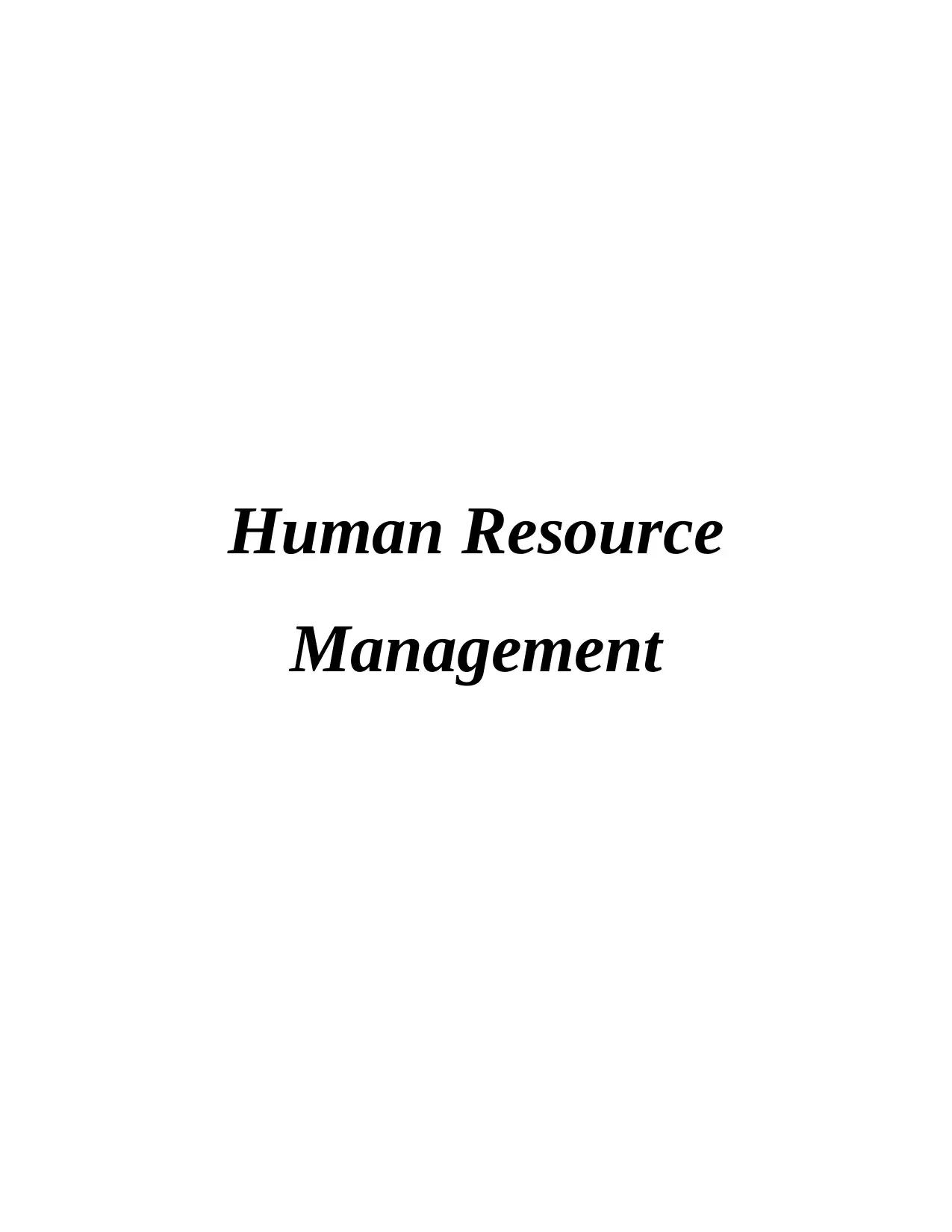
Human Resource
Management
Management
Paraphrase This Document
Need a fresh take? Get an instant paraphrase of this document with our AI Paraphraser

Table of Contents
INTRODUCTION...........................................................................................................................4
TASK 1............................................................................................................................................4
1.1 Differentiate among personnel and human resource management.......................................4
1.2 Functions regarding Human Resource Management............................................................5
1.3 Different responsibilities and roles of line managers in HRM.............................................5
1.4 Impact of regulatory and legal framework on HRM.............................................................6
TASK 2 ...........................................................................................................................................7
2.1 Reasons regarding human resource planning in an organisation..........................................7
2.2 Stages which are involved in human resource planning.......................................................7
2.3 Comparison of recruitment and selection process in different organisations.......................8
2.4 Effectiveness of selection and recruitment techniques in different organisation..................8
TASK 3 ...........................................................................................................................................9
3.1 Link between reward and motivational theory......................................................................9
3.2 Process of job evaluation and factors that determine pay.....................................................9
3.3 Effectiveness of reward system...........................................................................................11
3.4 Methods used to monitor performance of employees.........................................................12
TASK 4 ........................................................................................................................................13
4.1 Reasons regarding cessation of employment......................................................................13
4.2 Employment exit procedure in two organisations...............................................................13
4.3 Impact of regulatory and legal framework on the arrangements of employment cessation
...................................................................................................................................................14
CONCLUSION .............................................................................................................................14
REFERENCES..............................................................................................................................16
INTRODUCTION...........................................................................................................................4
TASK 1............................................................................................................................................4
1.1 Differentiate among personnel and human resource management.......................................4
1.2 Functions regarding Human Resource Management............................................................5
1.3 Different responsibilities and roles of line managers in HRM.............................................5
1.4 Impact of regulatory and legal framework on HRM.............................................................6
TASK 2 ...........................................................................................................................................7
2.1 Reasons regarding human resource planning in an organisation..........................................7
2.2 Stages which are involved in human resource planning.......................................................7
2.3 Comparison of recruitment and selection process in different organisations.......................8
2.4 Effectiveness of selection and recruitment techniques in different organisation..................8
TASK 3 ...........................................................................................................................................9
3.1 Link between reward and motivational theory......................................................................9
3.2 Process of job evaluation and factors that determine pay.....................................................9
3.3 Effectiveness of reward system...........................................................................................11
3.4 Methods used to monitor performance of employees.........................................................12
TASK 4 ........................................................................................................................................13
4.1 Reasons regarding cessation of employment......................................................................13
4.2 Employment exit procedure in two organisations...............................................................13
4.3 Impact of regulatory and legal framework on the arrangements of employment cessation
...................................................................................................................................................14
CONCLUSION .............................................................................................................................14
REFERENCES..............................................................................................................................16
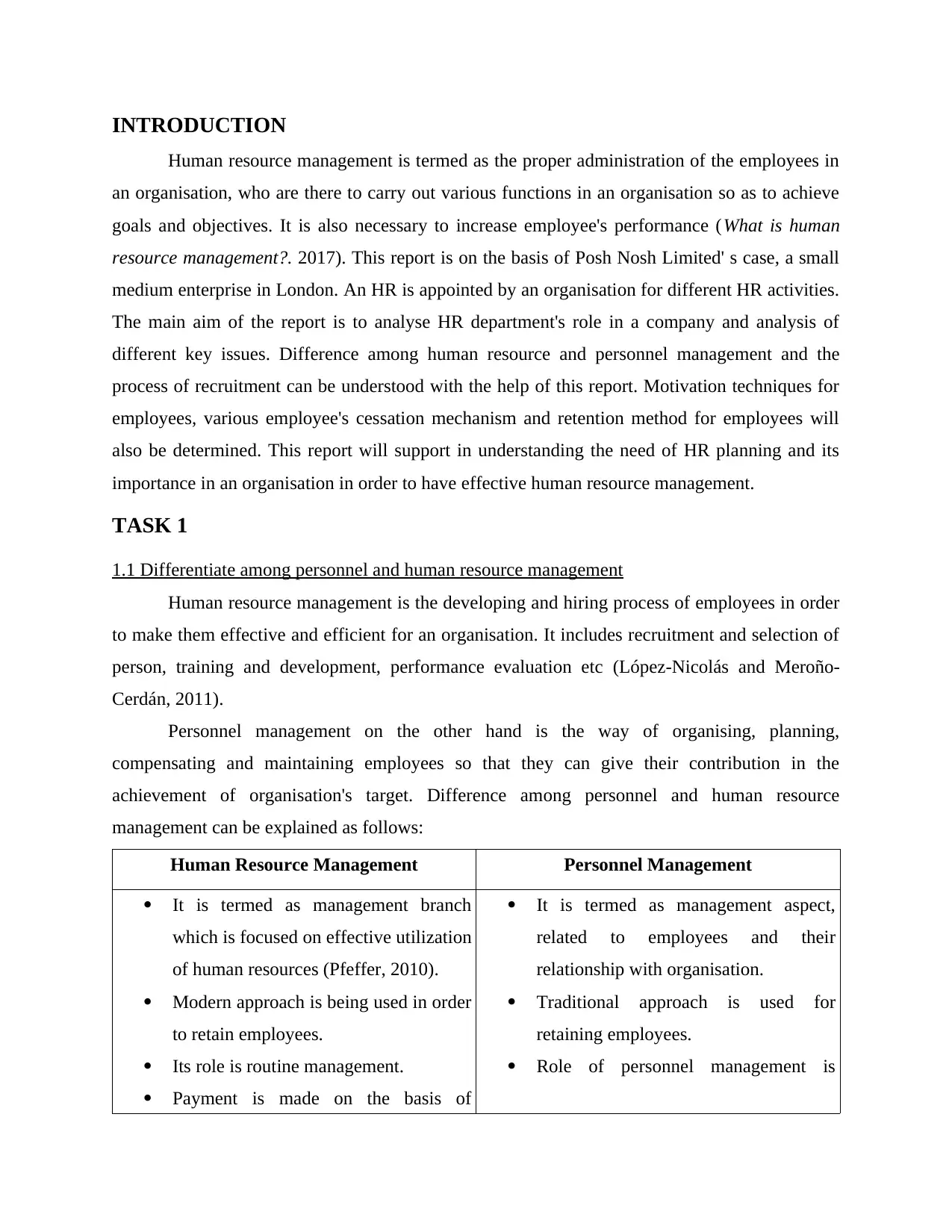
INTRODUCTION
Human resource management is termed as the proper administration of the employees in
an organisation, who are there to carry out various functions in an organisation so as to achieve
goals and objectives. It is also necessary to increase employee's performance (What is human
resource management?. 2017). This report is on the basis of Posh Nosh Limited' s case, a small
medium enterprise in London. An HR is appointed by an organisation for different HR activities.
The main aim of the report is to analyse HR department's role in a company and analysis of
different key issues. Difference among human resource and personnel management and the
process of recruitment can be understood with the help of this report. Motivation techniques for
employees, various employee's cessation mechanism and retention method for employees will
also be determined. This report will support in understanding the need of HR planning and its
importance in an organisation in order to have effective human resource management.
TASK 1
1.1 Differentiate among personnel and human resource management
Human resource management is the developing and hiring process of employees in order
to make them effective and efficient for an organisation. It includes recruitment and selection of
person, training and development, performance evaluation etc (López-Nicolás and Meroño-
Cerdán, 2011).
Personnel management on the other hand is the way of organising, planning,
compensating and maintaining employees so that they can give their contribution in the
achievement of organisation's target. Difference among personnel and human resource
management can be explained as follows:
Human Resource Management Personnel Management
It is termed as management branch
which is focused on effective utilization
of human resources (Pfeffer, 2010).
Modern approach is being used in order
to retain employees.
Its role is routine management.
Payment is made on the basis of
It is termed as management aspect,
related to employees and their
relationship with organisation.
Traditional approach is used for
retaining employees.
Role of personnel management is
Human resource management is termed as the proper administration of the employees in
an organisation, who are there to carry out various functions in an organisation so as to achieve
goals and objectives. It is also necessary to increase employee's performance (What is human
resource management?. 2017). This report is on the basis of Posh Nosh Limited' s case, a small
medium enterprise in London. An HR is appointed by an organisation for different HR activities.
The main aim of the report is to analyse HR department's role in a company and analysis of
different key issues. Difference among human resource and personnel management and the
process of recruitment can be understood with the help of this report. Motivation techniques for
employees, various employee's cessation mechanism and retention method for employees will
also be determined. This report will support in understanding the need of HR planning and its
importance in an organisation in order to have effective human resource management.
TASK 1
1.1 Differentiate among personnel and human resource management
Human resource management is the developing and hiring process of employees in order
to make them effective and efficient for an organisation. It includes recruitment and selection of
person, training and development, performance evaluation etc (López-Nicolás and Meroño-
Cerdán, 2011).
Personnel management on the other hand is the way of organising, planning,
compensating and maintaining employees so that they can give their contribution in the
achievement of organisation's target. Difference among personnel and human resource
management can be explained as follows:
Human Resource Management Personnel Management
It is termed as management branch
which is focused on effective utilization
of human resources (Pfeffer, 2010).
Modern approach is being used in order
to retain employees.
Its role is routine management.
Payment is made on the basis of
It is termed as management aspect,
related to employees and their
relationship with organisation.
Traditional approach is used for
retaining employees.
Role of personnel management is
⊘ This is a preview!⊘
Do you want full access?
Subscribe today to unlock all pages.

Trusted by 1+ million students worldwide
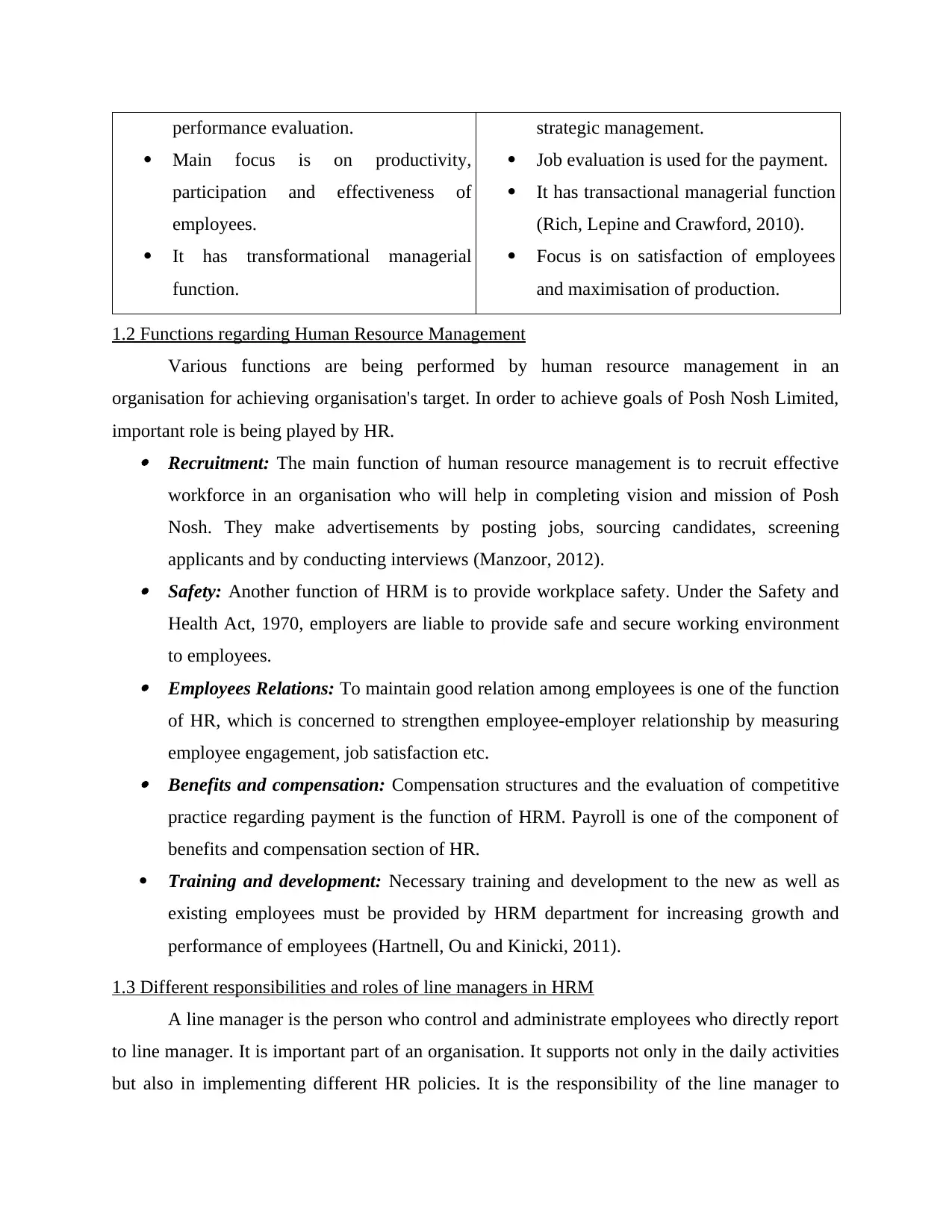
performance evaluation.
Main focus is on productivity,
participation and effectiveness of
employees.
It has transformational managerial
function.
strategic management.
Job evaluation is used for the payment.
It has transactional managerial function
(Rich, Lepine and Crawford, 2010).
Focus is on satisfaction of employees
and maximisation of production.
1.2 Functions regarding Human Resource Management
Various functions are being performed by human resource management in an
organisation for achieving organisation's target. In order to achieve goals of Posh Nosh Limited,
important role is being played by HR. Recruitment: The main function of human resource management is to recruit effective
workforce in an organisation who will help in completing vision and mission of Posh
Nosh. They make advertisements by posting jobs, sourcing candidates, screening
applicants and by conducting interviews (Manzoor, 2012). Safety: Another function of HRM is to provide workplace safety. Under the Safety and
Health Act, 1970, employers are liable to provide safe and secure working environment
to employees. Employees Relations: To maintain good relation among employees is one of the function
of HR, which is concerned to strengthen employee-employer relationship by measuring
employee engagement, job satisfaction etc. Benefits and compensation: Compensation structures and the evaluation of competitive
practice regarding payment is the function of HRM. Payroll is one of the component of
benefits and compensation section of HR.
Training and development: Necessary training and development to the new as well as
existing employees must be provided by HRM department for increasing growth and
performance of employees (Hartnell, Ou and Kinicki, 2011).
1.3 Different responsibilities and roles of line managers in HRM
A line manager is the person who control and administrate employees who directly report
to line manager. It is important part of an organisation. It supports not only in the daily activities
but also in implementing different HR policies. It is the responsibility of the line manager to
Main focus is on productivity,
participation and effectiveness of
employees.
It has transformational managerial
function.
strategic management.
Job evaluation is used for the payment.
It has transactional managerial function
(Rich, Lepine and Crawford, 2010).
Focus is on satisfaction of employees
and maximisation of production.
1.2 Functions regarding Human Resource Management
Various functions are being performed by human resource management in an
organisation for achieving organisation's target. In order to achieve goals of Posh Nosh Limited,
important role is being played by HR. Recruitment: The main function of human resource management is to recruit effective
workforce in an organisation who will help in completing vision and mission of Posh
Nosh. They make advertisements by posting jobs, sourcing candidates, screening
applicants and by conducting interviews (Manzoor, 2012). Safety: Another function of HRM is to provide workplace safety. Under the Safety and
Health Act, 1970, employers are liable to provide safe and secure working environment
to employees. Employees Relations: To maintain good relation among employees is one of the function
of HR, which is concerned to strengthen employee-employer relationship by measuring
employee engagement, job satisfaction etc. Benefits and compensation: Compensation structures and the evaluation of competitive
practice regarding payment is the function of HRM. Payroll is one of the component of
benefits and compensation section of HR.
Training and development: Necessary training and development to the new as well as
existing employees must be provided by HRM department for increasing growth and
performance of employees (Hartnell, Ou and Kinicki, 2011).
1.3 Different responsibilities and roles of line managers in HRM
A line manager is the person who control and administrate employees who directly report
to line manager. It is important part of an organisation. It supports not only in the daily activities
but also in implementing different HR policies. It is the responsibility of the line manager to
Paraphrase This Document
Need a fresh take? Get an instant paraphrase of this document with our AI Paraphraser
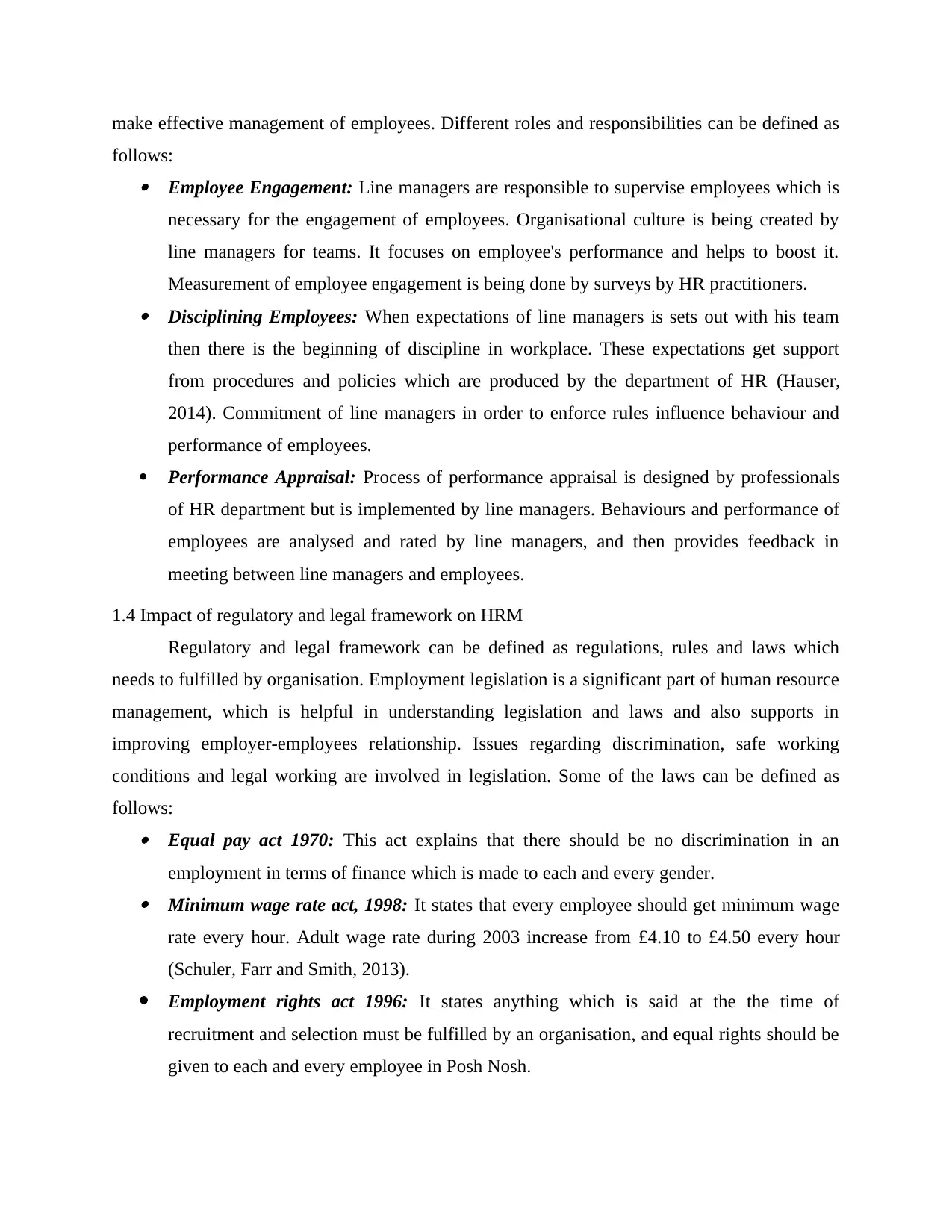
make effective management of employees. Different roles and responsibilities can be defined as
follows: Employee Engagement: Line managers are responsible to supervise employees which is
necessary for the engagement of employees. Organisational culture is being created by
line managers for teams. It focuses on employee's performance and helps to boost it.
Measurement of employee engagement is being done by surveys by HR practitioners. Disciplining Employees: When expectations of line managers is sets out with his team
then there is the beginning of discipline in workplace. These expectations get support
from procedures and policies which are produced by the department of HR (Hauser,
2014). Commitment of line managers in order to enforce rules influence behaviour and
performance of employees.
Performance Appraisal: Process of performance appraisal is designed by professionals
of HR department but is implemented by line managers. Behaviours and performance of
employees are analysed and rated by line managers, and then provides feedback in
meeting between line managers and employees.
1.4 Impact of regulatory and legal framework on HRM
Regulatory and legal framework can be defined as regulations, rules and laws which
needs to fulfilled by organisation. Employment legislation is a significant part of human resource
management, which is helpful in understanding legislation and laws and also supports in
improving employer-employees relationship. Issues regarding discrimination, safe working
conditions and legal working are involved in legislation. Some of the laws can be defined as
follows: Equal pay act 1970: This act explains that there should be no discrimination in an
employment in terms of finance which is made to each and every gender. Minimum wage rate act, 1998: It states that every employee should get minimum wage
rate every hour. Adult wage rate during 2003 increase from £4.10 to £4.50 every hour
(Schuler, Farr and Smith, 2013).
Employment rights act 1996: It states anything which is said at the the time of
recruitment and selection must be fulfilled by an organisation, and equal rights should be
given to each and every employee in Posh Nosh.
follows: Employee Engagement: Line managers are responsible to supervise employees which is
necessary for the engagement of employees. Organisational culture is being created by
line managers for teams. It focuses on employee's performance and helps to boost it.
Measurement of employee engagement is being done by surveys by HR practitioners. Disciplining Employees: When expectations of line managers is sets out with his team
then there is the beginning of discipline in workplace. These expectations get support
from procedures and policies which are produced by the department of HR (Hauser,
2014). Commitment of line managers in order to enforce rules influence behaviour and
performance of employees.
Performance Appraisal: Process of performance appraisal is designed by professionals
of HR department but is implemented by line managers. Behaviours and performance of
employees are analysed and rated by line managers, and then provides feedback in
meeting between line managers and employees.
1.4 Impact of regulatory and legal framework on HRM
Regulatory and legal framework can be defined as regulations, rules and laws which
needs to fulfilled by organisation. Employment legislation is a significant part of human resource
management, which is helpful in understanding legislation and laws and also supports in
improving employer-employees relationship. Issues regarding discrimination, safe working
conditions and legal working are involved in legislation. Some of the laws can be defined as
follows: Equal pay act 1970: This act explains that there should be no discrimination in an
employment in terms of finance which is made to each and every gender. Minimum wage rate act, 1998: It states that every employee should get minimum wage
rate every hour. Adult wage rate during 2003 increase from £4.10 to £4.50 every hour
(Schuler, Farr and Smith, 2013).
Employment rights act 1996: It states anything which is said at the the time of
recruitment and selection must be fulfilled by an organisation, and equal rights should be
given to each and every employee in Posh Nosh.
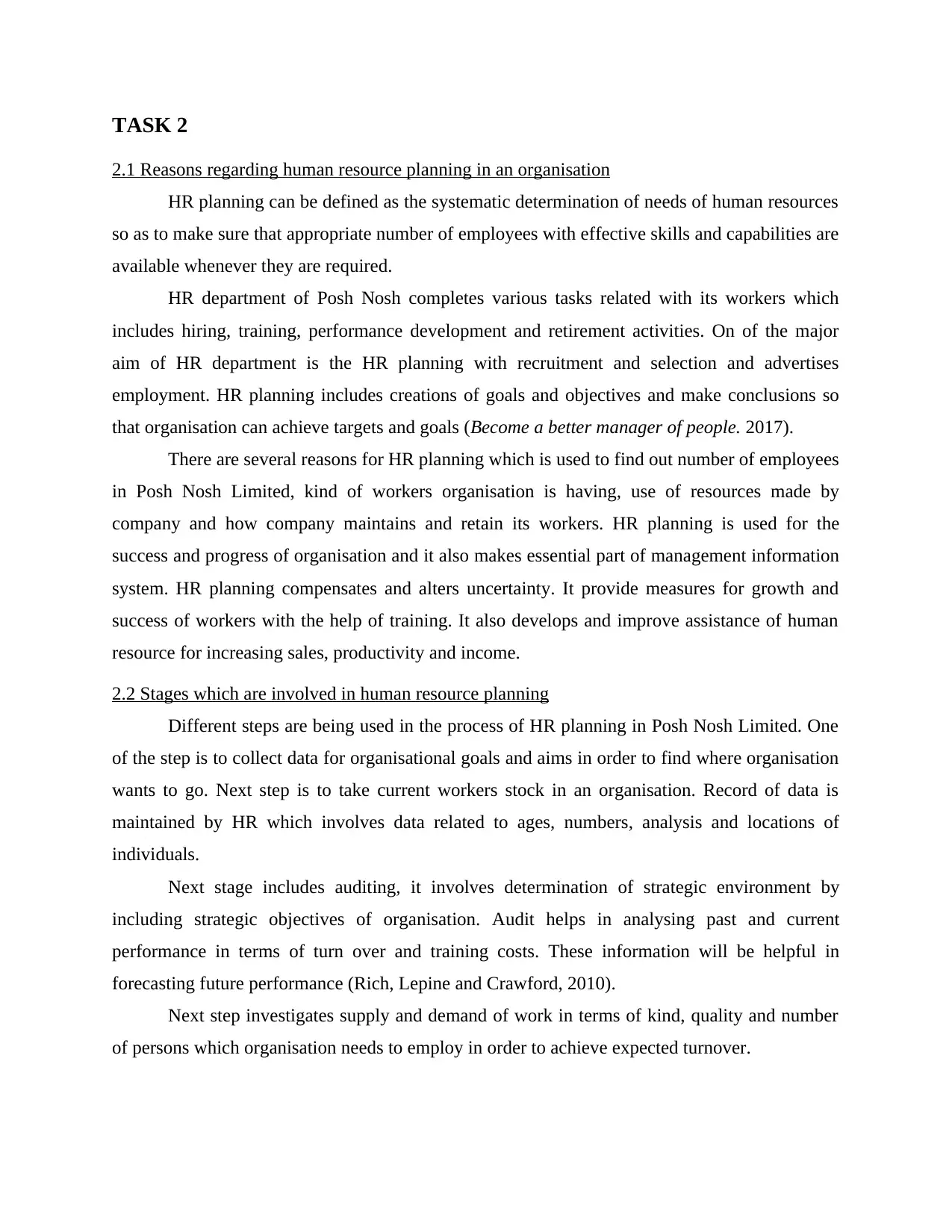
TASK 2
2.1 Reasons regarding human resource planning in an organisation
HR planning can be defined as the systematic determination of needs of human resources
so as to make sure that appropriate number of employees with effective skills and capabilities are
available whenever they are required.
HR department of Posh Nosh completes various tasks related with its workers which
includes hiring, training, performance development and retirement activities. On of the major
aim of HR department is the HR planning with recruitment and selection and advertises
employment. HR planning includes creations of goals and objectives and make conclusions so
that organisation can achieve targets and goals (Become a better manager of people. 2017).
There are several reasons for HR planning which is used to find out number of employees
in Posh Nosh Limited, kind of workers organisation is having, use of resources made by
company and how company maintains and retain its workers. HR planning is used for the
success and progress of organisation and it also makes essential part of management information
system. HR planning compensates and alters uncertainty. It provide measures for growth and
success of workers with the help of training. It also develops and improve assistance of human
resource for increasing sales, productivity and income.
2.2 Stages which are involved in human resource planning
Different steps are being used in the process of HR planning in Posh Nosh Limited. One
of the step is to collect data for organisational goals and aims in order to find where organisation
wants to go. Next step is to take current workers stock in an organisation. Record of data is
maintained by HR which involves data related to ages, numbers, analysis and locations of
individuals.
Next stage includes auditing, it involves determination of strategic environment by
including strategic objectives of organisation. Audit helps in analysing past and current
performance in terms of turn over and training costs. These information will be helpful in
forecasting future performance (Rich, Lepine and Crawford, 2010).
Next step investigates supply and demand of work in terms of kind, quality and number
of persons which organisation needs to employ in order to achieve expected turnover.
2.1 Reasons regarding human resource planning in an organisation
HR planning can be defined as the systematic determination of needs of human resources
so as to make sure that appropriate number of employees with effective skills and capabilities are
available whenever they are required.
HR department of Posh Nosh completes various tasks related with its workers which
includes hiring, training, performance development and retirement activities. On of the major
aim of HR department is the HR planning with recruitment and selection and advertises
employment. HR planning includes creations of goals and objectives and make conclusions so
that organisation can achieve targets and goals (Become a better manager of people. 2017).
There are several reasons for HR planning which is used to find out number of employees
in Posh Nosh Limited, kind of workers organisation is having, use of resources made by
company and how company maintains and retain its workers. HR planning is used for the
success and progress of organisation and it also makes essential part of management information
system. HR planning compensates and alters uncertainty. It provide measures for growth and
success of workers with the help of training. It also develops and improve assistance of human
resource for increasing sales, productivity and income.
2.2 Stages which are involved in human resource planning
Different steps are being used in the process of HR planning in Posh Nosh Limited. One
of the step is to collect data for organisational goals and aims in order to find where organisation
wants to go. Next step is to take current workers stock in an organisation. Record of data is
maintained by HR which involves data related to ages, numbers, analysis and locations of
individuals.
Next stage includes auditing, it involves determination of strategic environment by
including strategic objectives of organisation. Audit helps in analysing past and current
performance in terms of turn over and training costs. These information will be helpful in
forecasting future performance (Rich, Lepine and Crawford, 2010).
Next step investigates supply and demand of work in terms of kind, quality and number
of persons which organisation needs to employ in order to achieve expected turnover.
⊘ This is a preview!⊘
Do you want full access?
Subscribe today to unlock all pages.

Trusted by 1+ million students worldwide
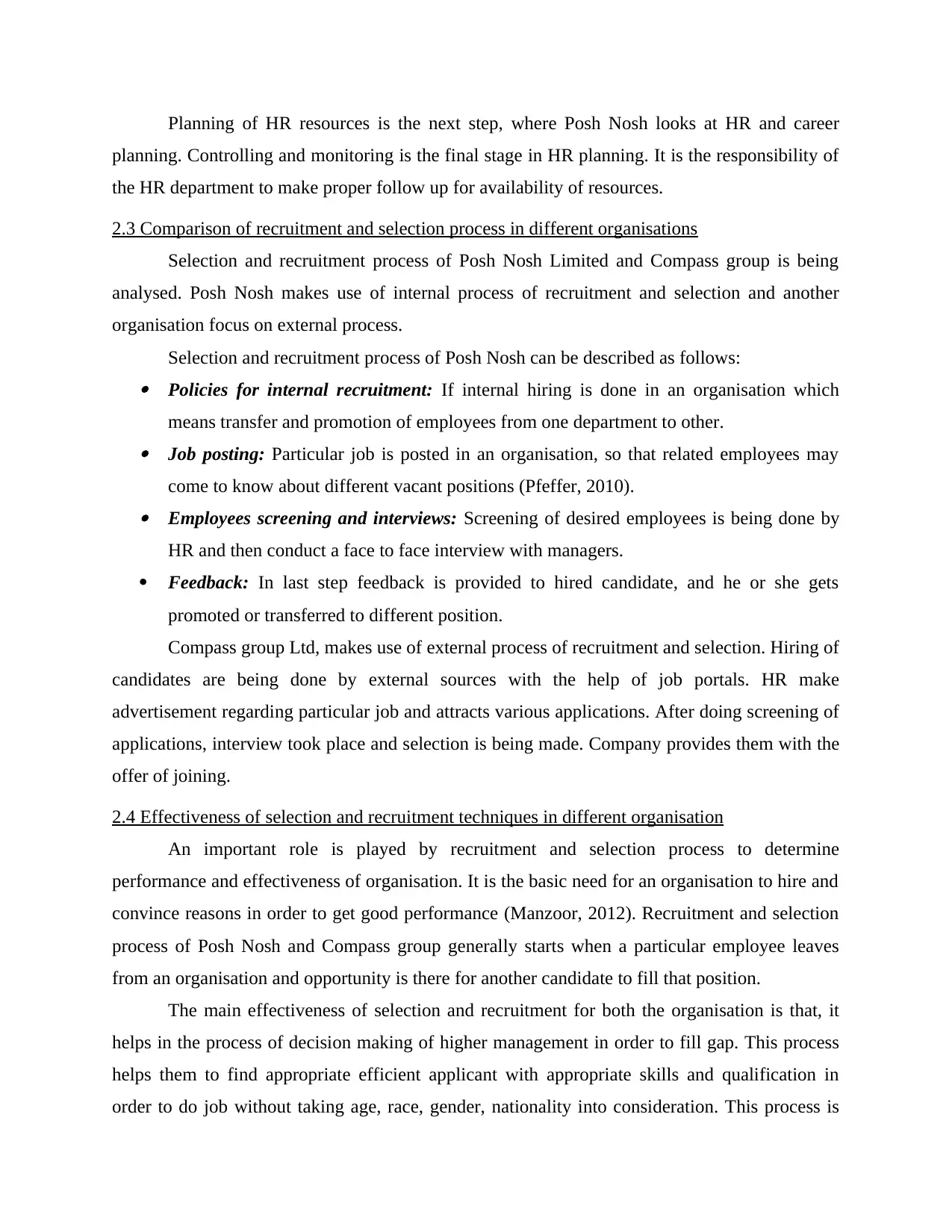
Planning of HR resources is the next step, where Posh Nosh looks at HR and career
planning. Controlling and monitoring is the final stage in HR planning. It is the responsibility of
the HR department to make proper follow up for availability of resources.
2.3 Comparison of recruitment and selection process in different organisations
Selection and recruitment process of Posh Nosh Limited and Compass group is being
analysed. Posh Nosh makes use of internal process of recruitment and selection and another
organisation focus on external process.
Selection and recruitment process of Posh Nosh can be described as follows: Policies for internal recruitment: If internal hiring is done in an organisation which
means transfer and promotion of employees from one department to other. Job posting: Particular job is posted in an organisation, so that related employees may
come to know about different vacant positions (Pfeffer, 2010). Employees screening and interviews: Screening of desired employees is being done by
HR and then conduct a face to face interview with managers.
Feedback: In last step feedback is provided to hired candidate, and he or she gets
promoted or transferred to different position.
Compass group Ltd, makes use of external process of recruitment and selection. Hiring of
candidates are being done by external sources with the help of job portals. HR make
advertisement regarding particular job and attracts various applications. After doing screening of
applications, interview took place and selection is being made. Company provides them with the
offer of joining.
2.4 Effectiveness of selection and recruitment techniques in different organisation
An important role is played by recruitment and selection process to determine
performance and effectiveness of organisation. It is the basic need for an organisation to hire and
convince reasons in order to get good performance (Manzoor, 2012). Recruitment and selection
process of Posh Nosh and Compass group generally starts when a particular employee leaves
from an organisation and opportunity is there for another candidate to fill that position.
The main effectiveness of selection and recruitment for both the organisation is that, it
helps in the process of decision making of higher management in order to fill gap. This process
helps them to find appropriate efficient applicant with appropriate skills and qualification in
order to do job without taking age, race, gender, nationality into consideration. This process is
planning. Controlling and monitoring is the final stage in HR planning. It is the responsibility of
the HR department to make proper follow up for availability of resources.
2.3 Comparison of recruitment and selection process in different organisations
Selection and recruitment process of Posh Nosh Limited and Compass group is being
analysed. Posh Nosh makes use of internal process of recruitment and selection and another
organisation focus on external process.
Selection and recruitment process of Posh Nosh can be described as follows: Policies for internal recruitment: If internal hiring is done in an organisation which
means transfer and promotion of employees from one department to other. Job posting: Particular job is posted in an organisation, so that related employees may
come to know about different vacant positions (Pfeffer, 2010). Employees screening and interviews: Screening of desired employees is being done by
HR and then conduct a face to face interview with managers.
Feedback: In last step feedback is provided to hired candidate, and he or she gets
promoted or transferred to different position.
Compass group Ltd, makes use of external process of recruitment and selection. Hiring of
candidates are being done by external sources with the help of job portals. HR make
advertisement regarding particular job and attracts various applications. After doing screening of
applications, interview took place and selection is being made. Company provides them with the
offer of joining.
2.4 Effectiveness of selection and recruitment techniques in different organisation
An important role is played by recruitment and selection process to determine
performance and effectiveness of organisation. It is the basic need for an organisation to hire and
convince reasons in order to get good performance (Manzoor, 2012). Recruitment and selection
process of Posh Nosh and Compass group generally starts when a particular employee leaves
from an organisation and opportunity is there for another candidate to fill that position.
The main effectiveness of selection and recruitment for both the organisation is that, it
helps in the process of decision making of higher management in order to fill gap. This process
helps them to find appropriate efficient applicant with appropriate skills and qualification in
order to do job without taking age, race, gender, nationality into consideration. This process is
Paraphrase This Document
Need a fresh take? Get an instant paraphrase of this document with our AI Paraphraser
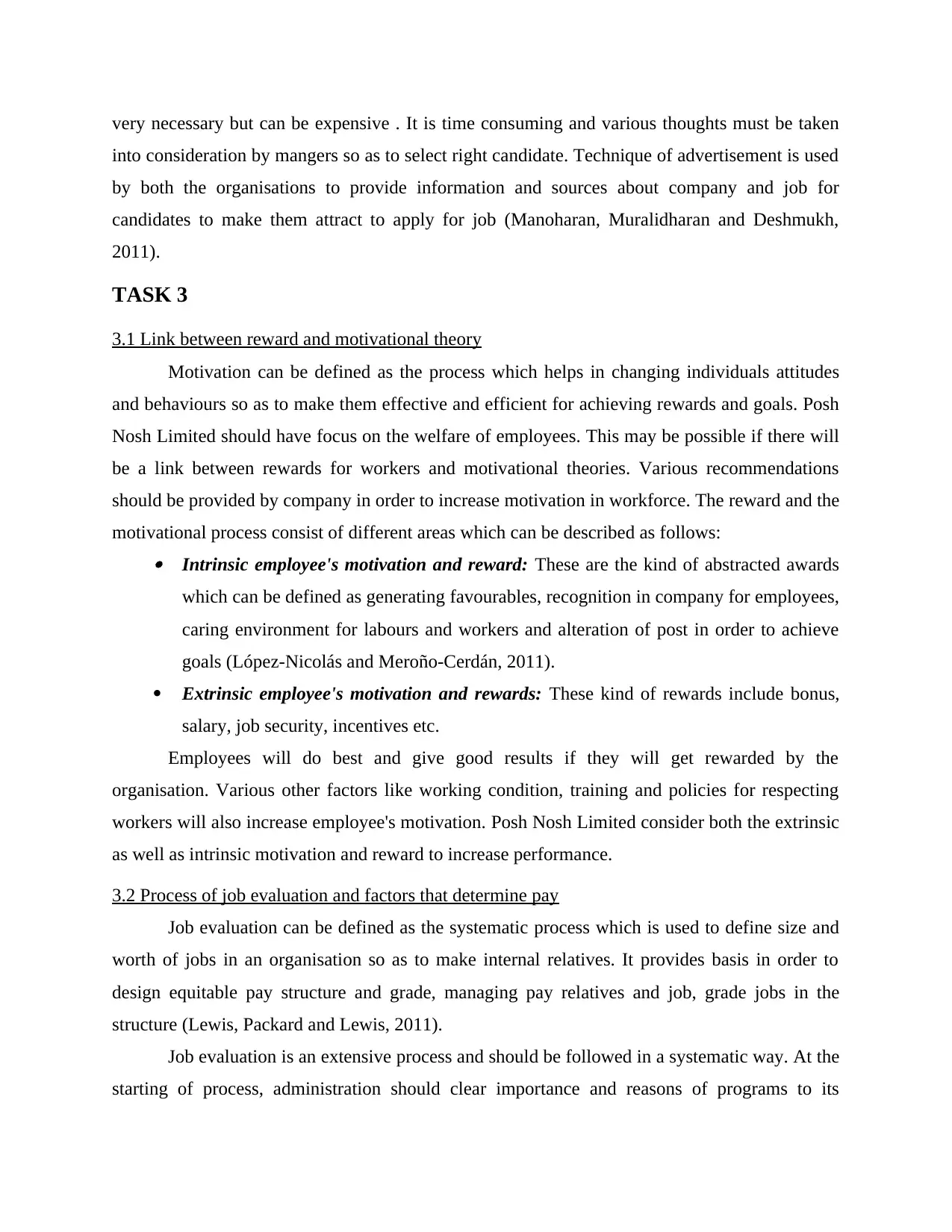
very necessary but can be expensive . It is time consuming and various thoughts must be taken
into consideration by mangers so as to select right candidate. Technique of advertisement is used
by both the organisations to provide information and sources about company and job for
candidates to make them attract to apply for job (Manoharan, Muralidharan and Deshmukh,
2011).
TASK 3
3.1 Link between reward and motivational theory
Motivation can be defined as the process which helps in changing individuals attitudes
and behaviours so as to make them effective and efficient for achieving rewards and goals. Posh
Nosh Limited should have focus on the welfare of employees. This may be possible if there will
be a link between rewards for workers and motivational theories. Various recommendations
should be provided by company in order to increase motivation in workforce. The reward and the
motivational process consist of different areas which can be described as follows: Intrinsic employee's motivation and reward: These are the kind of abstracted awards
which can be defined as generating favourables, recognition in company for employees,
caring environment for labours and workers and alteration of post in order to achieve
goals (López-Nicolás and Meroño-Cerdán, 2011).
Extrinsic employee's motivation and rewards: These kind of rewards include bonus,
salary, job security, incentives etc.
Employees will do best and give good results if they will get rewarded by the
organisation. Various other factors like working condition, training and policies for respecting
workers will also increase employee's motivation. Posh Nosh Limited consider both the extrinsic
as well as intrinsic motivation and reward to increase performance.
3.2 Process of job evaluation and factors that determine pay
Job evaluation can be defined as the systematic process which is used to define size and
worth of jobs in an organisation so as to make internal relatives. It provides basis in order to
design equitable pay structure and grade, managing pay relatives and job, grade jobs in the
structure (Lewis, Packard and Lewis, 2011).
Job evaluation is an extensive process and should be followed in a systematic way. At the
starting of process, administration should clear importance and reasons of programs to its
into consideration by mangers so as to select right candidate. Technique of advertisement is used
by both the organisations to provide information and sources about company and job for
candidates to make them attract to apply for job (Manoharan, Muralidharan and Deshmukh,
2011).
TASK 3
3.1 Link between reward and motivational theory
Motivation can be defined as the process which helps in changing individuals attitudes
and behaviours so as to make them effective and efficient for achieving rewards and goals. Posh
Nosh Limited should have focus on the welfare of employees. This may be possible if there will
be a link between rewards for workers and motivational theories. Various recommendations
should be provided by company in order to increase motivation in workforce. The reward and the
motivational process consist of different areas which can be described as follows: Intrinsic employee's motivation and reward: These are the kind of abstracted awards
which can be defined as generating favourables, recognition in company for employees,
caring environment for labours and workers and alteration of post in order to achieve
goals (López-Nicolás and Meroño-Cerdán, 2011).
Extrinsic employee's motivation and rewards: These kind of rewards include bonus,
salary, job security, incentives etc.
Employees will do best and give good results if they will get rewarded by the
organisation. Various other factors like working condition, training and policies for respecting
workers will also increase employee's motivation. Posh Nosh Limited consider both the extrinsic
as well as intrinsic motivation and reward to increase performance.
3.2 Process of job evaluation and factors that determine pay
Job evaluation can be defined as the systematic process which is used to define size and
worth of jobs in an organisation so as to make internal relatives. It provides basis in order to
design equitable pay structure and grade, managing pay relatives and job, grade jobs in the
structure (Lewis, Packard and Lewis, 2011).
Job evaluation is an extensive process and should be followed in a systematic way. At the
starting of process, administration should clear importance and reasons of programs to its
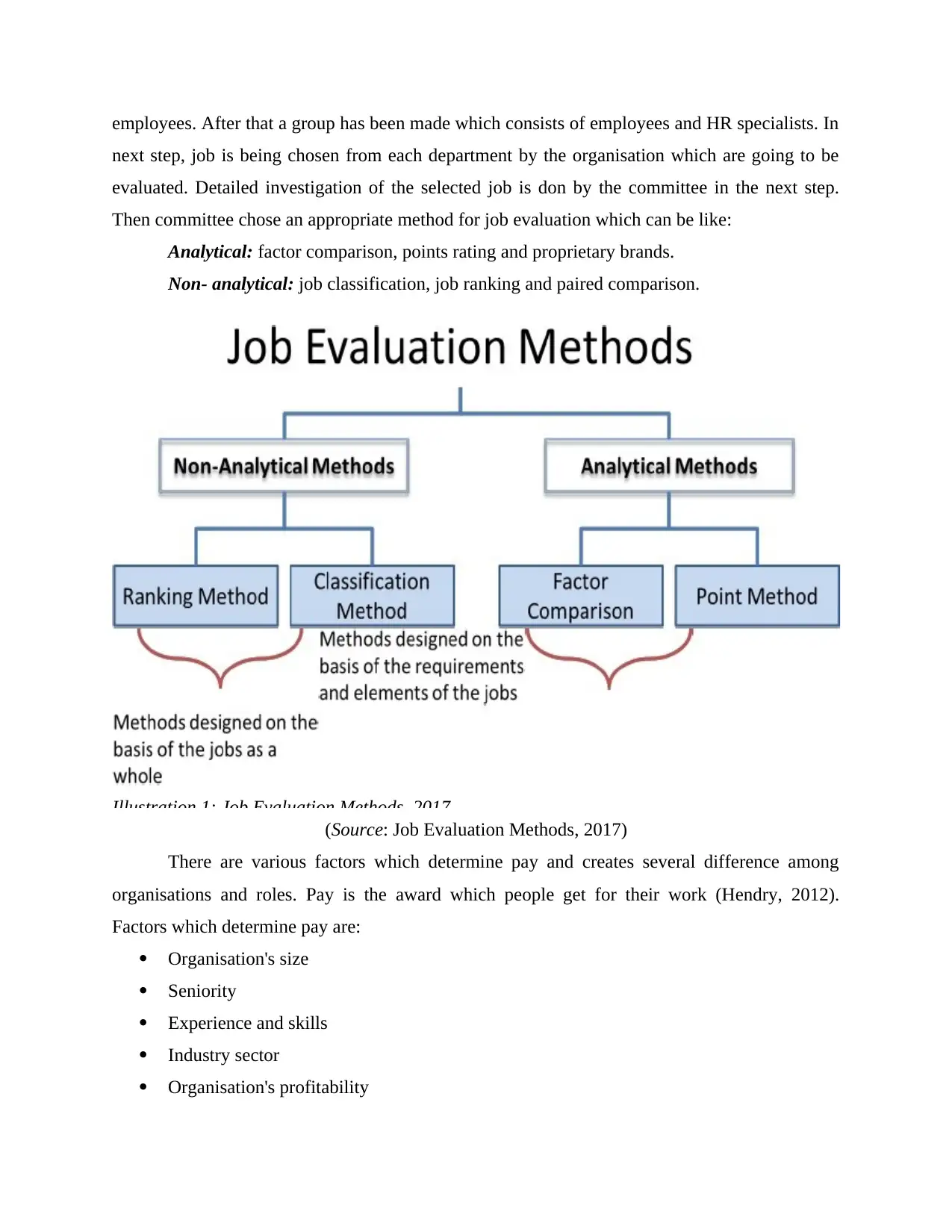
employees. After that a group has been made which consists of employees and HR specialists. In
next step, job is being chosen from each department by the organisation which are going to be
evaluated. Detailed investigation of the selected job is don by the committee in the next step.
Then committee chose an appropriate method for job evaluation which can be like:
Analytical: factor comparison, points rating and proprietary brands.
Non- analytical: job classification, job ranking and paired comparison.
(Source: Job Evaluation Methods, 2017)
There are various factors which determine pay and creates several difference among
organisations and roles. Pay is the award which people get for their work (Hendry, 2012).
Factors which determine pay are:
Organisation's size
Seniority
Experience and skills
Industry sector
Organisation's profitability
Illustration 1: Job Evaluation Methods, 2017
next step, job is being chosen from each department by the organisation which are going to be
evaluated. Detailed investigation of the selected job is don by the committee in the next step.
Then committee chose an appropriate method for job evaluation which can be like:
Analytical: factor comparison, points rating and proprietary brands.
Non- analytical: job classification, job ranking and paired comparison.
(Source: Job Evaluation Methods, 2017)
There are various factors which determine pay and creates several difference among
organisations and roles. Pay is the award which people get for their work (Hendry, 2012).
Factors which determine pay are:
Organisation's size
Seniority
Experience and skills
Industry sector
Organisation's profitability
Illustration 1: Job Evaluation Methods, 2017
⊘ This is a preview!⊘
Do you want full access?
Subscribe today to unlock all pages.

Trusted by 1+ million students worldwide
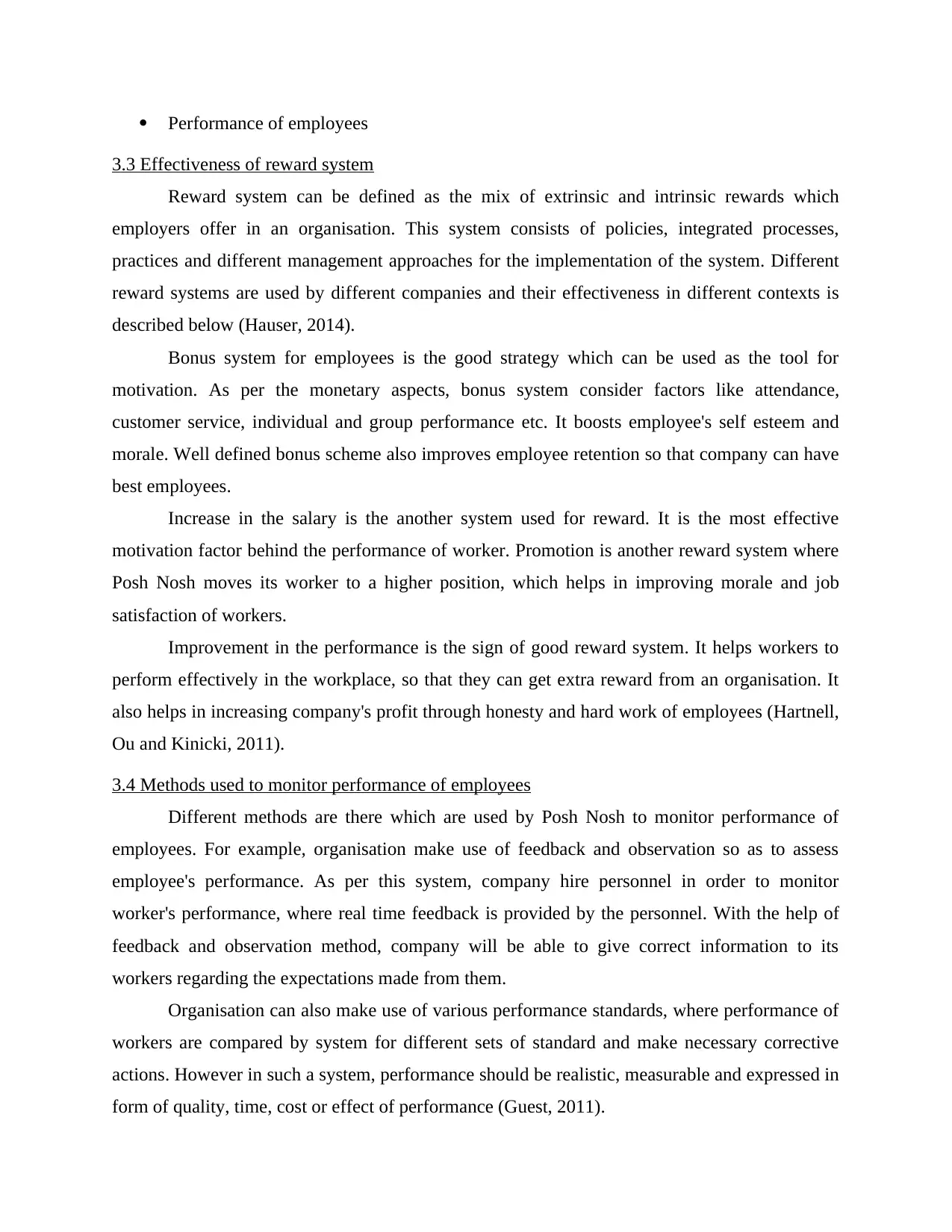
Performance of employees
3.3 Effectiveness of reward system
Reward system can be defined as the mix of extrinsic and intrinsic rewards which
employers offer in an organisation. This system consists of policies, integrated processes,
practices and different management approaches for the implementation of the system. Different
reward systems are used by different companies and their effectiveness in different contexts is
described below (Hauser, 2014).
Bonus system for employees is the good strategy which can be used as the tool for
motivation. As per the monetary aspects, bonus system consider factors like attendance,
customer service, individual and group performance etc. It boosts employee's self esteem and
morale. Well defined bonus scheme also improves employee retention so that company can have
best employees.
Increase in the salary is the another system used for reward. It is the most effective
motivation factor behind the performance of worker. Promotion is another reward system where
Posh Nosh moves its worker to a higher position, which helps in improving morale and job
satisfaction of workers.
Improvement in the performance is the sign of good reward system. It helps workers to
perform effectively in the workplace, so that they can get extra reward from an organisation. It
also helps in increasing company's profit through honesty and hard work of employees (Hartnell,
Ou and Kinicki, 2011).
3.4 Methods used to monitor performance of employees
Different methods are there which are used by Posh Nosh to monitor performance of
employees. For example, organisation make use of feedback and observation so as to assess
employee's performance. As per this system, company hire personnel in order to monitor
worker's performance, where real time feedback is provided by the personnel. With the help of
feedback and observation method, company will be able to give correct information to its
workers regarding the expectations made from them.
Organisation can also make use of various performance standards, where performance of
workers are compared by system for different sets of standard and make necessary corrective
actions. However in such a system, performance should be realistic, measurable and expressed in
form of quality, time, cost or effect of performance (Guest, 2011).
3.3 Effectiveness of reward system
Reward system can be defined as the mix of extrinsic and intrinsic rewards which
employers offer in an organisation. This system consists of policies, integrated processes,
practices and different management approaches for the implementation of the system. Different
reward systems are used by different companies and their effectiveness in different contexts is
described below (Hauser, 2014).
Bonus system for employees is the good strategy which can be used as the tool for
motivation. As per the monetary aspects, bonus system consider factors like attendance,
customer service, individual and group performance etc. It boosts employee's self esteem and
morale. Well defined bonus scheme also improves employee retention so that company can have
best employees.
Increase in the salary is the another system used for reward. It is the most effective
motivation factor behind the performance of worker. Promotion is another reward system where
Posh Nosh moves its worker to a higher position, which helps in improving morale and job
satisfaction of workers.
Improvement in the performance is the sign of good reward system. It helps workers to
perform effectively in the workplace, so that they can get extra reward from an organisation. It
also helps in increasing company's profit through honesty and hard work of employees (Hartnell,
Ou and Kinicki, 2011).
3.4 Methods used to monitor performance of employees
Different methods are there which are used by Posh Nosh to monitor performance of
employees. For example, organisation make use of feedback and observation so as to assess
employee's performance. As per this system, company hire personnel in order to monitor
worker's performance, where real time feedback is provided by the personnel. With the help of
feedback and observation method, company will be able to give correct information to its
workers regarding the expectations made from them.
Organisation can also make use of various performance standards, where performance of
workers are compared by system for different sets of standard and make necessary corrective
actions. However in such a system, performance should be realistic, measurable and expressed in
form of quality, time, cost or effect of performance (Guest, 2011).
Paraphrase This Document
Need a fresh take? Get an instant paraphrase of this document with our AI Paraphraser
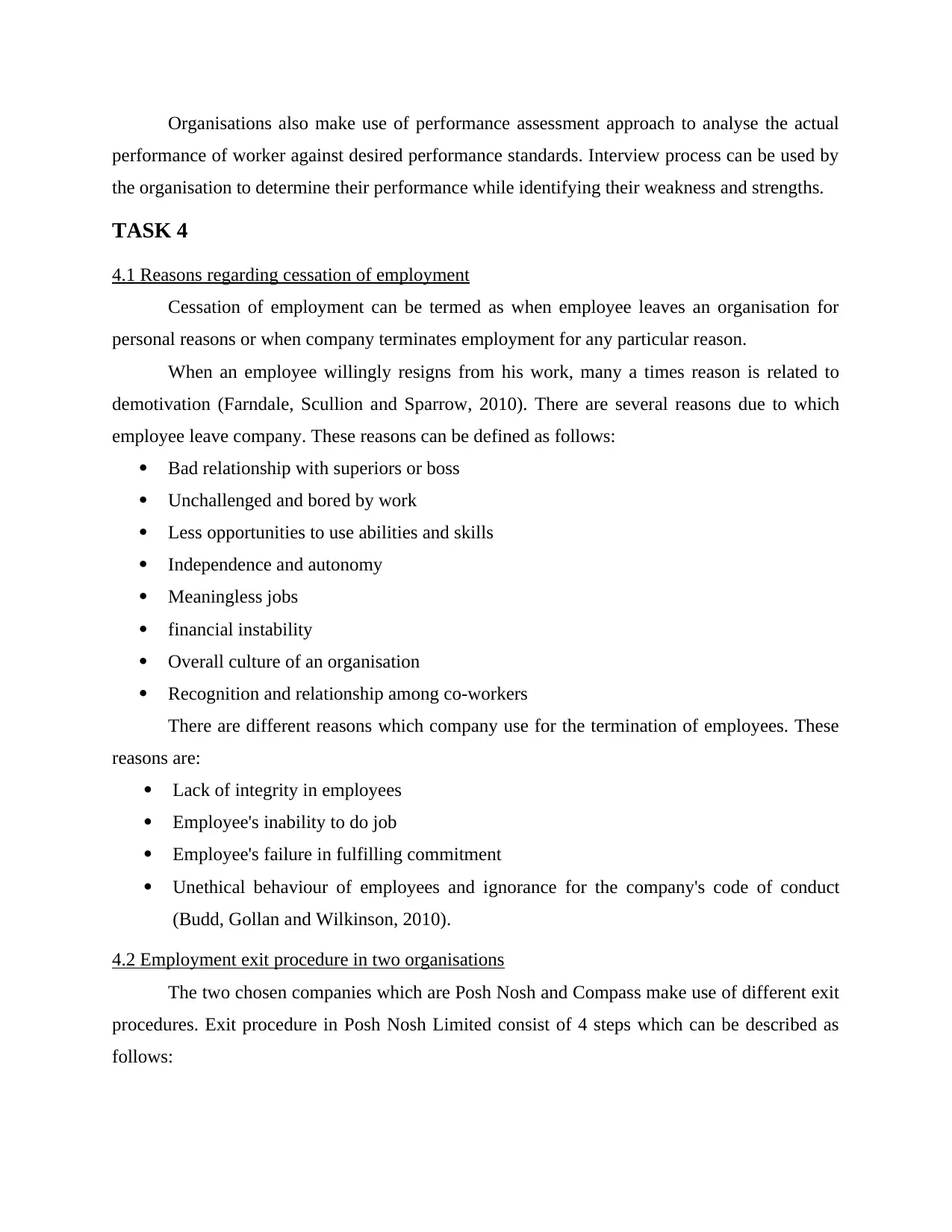
Organisations also make use of performance assessment approach to analyse the actual
performance of worker against desired performance standards. Interview process can be used by
the organisation to determine their performance while identifying their weakness and strengths.
TASK 4
4.1 Reasons regarding cessation of employment
Cessation of employment can be termed as when employee leaves an organisation for
personal reasons or when company terminates employment for any particular reason.
When an employee willingly resigns from his work, many a times reason is related to
demotivation (Farndale, Scullion and Sparrow, 2010). There are several reasons due to which
employee leave company. These reasons can be defined as follows:
Bad relationship with superiors or boss
Unchallenged and bored by work
Less opportunities to use abilities and skills
Independence and autonomy
Meaningless jobs
financial instability
Overall culture of an organisation
Recognition and relationship among co-workers
There are different reasons which company use for the termination of employees. These
reasons are:
Lack of integrity in employees
Employee's inability to do job
Employee's failure in fulfilling commitment
Unethical behaviour of employees and ignorance for the company's code of conduct
(Budd, Gollan and Wilkinson, 2010).
4.2 Employment exit procedure in two organisations
The two chosen companies which are Posh Nosh and Compass make use of different exit
procedures. Exit procedure in Posh Nosh Limited consist of 4 steps which can be described as
follows:
performance of worker against desired performance standards. Interview process can be used by
the organisation to determine their performance while identifying their weakness and strengths.
TASK 4
4.1 Reasons regarding cessation of employment
Cessation of employment can be termed as when employee leaves an organisation for
personal reasons or when company terminates employment for any particular reason.
When an employee willingly resigns from his work, many a times reason is related to
demotivation (Farndale, Scullion and Sparrow, 2010). There are several reasons due to which
employee leave company. These reasons can be defined as follows:
Bad relationship with superiors or boss
Unchallenged and bored by work
Less opportunities to use abilities and skills
Independence and autonomy
Meaningless jobs
financial instability
Overall culture of an organisation
Recognition and relationship among co-workers
There are different reasons which company use for the termination of employees. These
reasons are:
Lack of integrity in employees
Employee's inability to do job
Employee's failure in fulfilling commitment
Unethical behaviour of employees and ignorance for the company's code of conduct
(Budd, Gollan and Wilkinson, 2010).
4.2 Employment exit procedure in two organisations
The two chosen companies which are Posh Nosh and Compass make use of different exit
procedures. Exit procedure in Posh Nosh Limited consist of 4 steps which can be described as
follows:
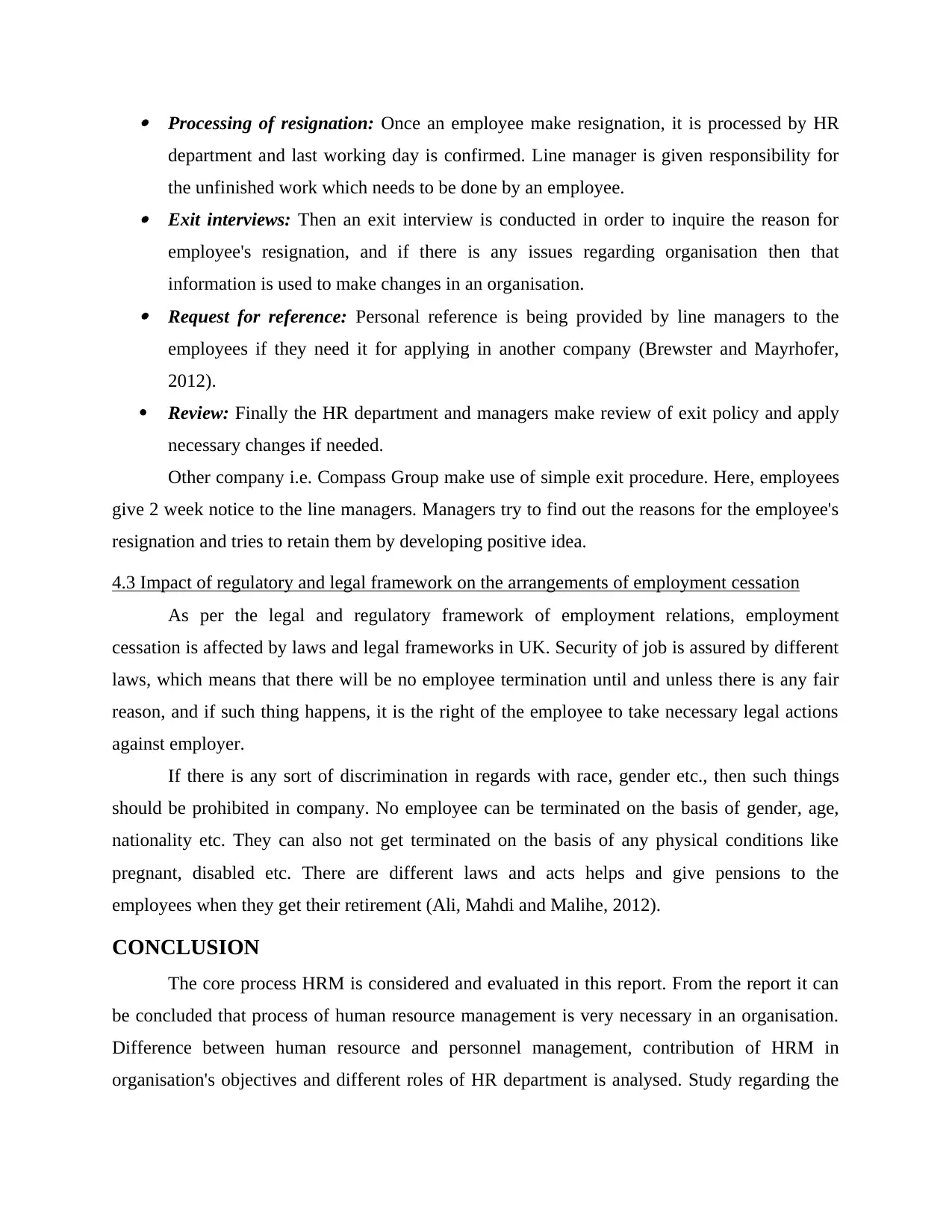
Processing of resignation: Once an employee make resignation, it is processed by HR
department and last working day is confirmed. Line manager is given responsibility for
the unfinished work which needs to be done by an employee. Exit interviews: Then an exit interview is conducted in order to inquire the reason for
employee's resignation, and if there is any issues regarding organisation then that
information is used to make changes in an organisation. Request for reference: Personal reference is being provided by line managers to the
employees if they need it for applying in another company (Brewster and Mayrhofer,
2012).
Review: Finally the HR department and managers make review of exit policy and apply
necessary changes if needed.
Other company i.e. Compass Group make use of simple exit procedure. Here, employees
give 2 week notice to the line managers. Managers try to find out the reasons for the employee's
resignation and tries to retain them by developing positive idea.
4.3 Impact of regulatory and legal framework on the arrangements of employment cessation
As per the legal and regulatory framework of employment relations, employment
cessation is affected by laws and legal frameworks in UK. Security of job is assured by different
laws, which means that there will be no employee termination until and unless there is any fair
reason, and if such thing happens, it is the right of the employee to take necessary legal actions
against employer.
If there is any sort of discrimination in regards with race, gender etc., then such things
should be prohibited in company. No employee can be terminated on the basis of gender, age,
nationality etc. They can also not get terminated on the basis of any physical conditions like
pregnant, disabled etc. There are different laws and acts helps and give pensions to the
employees when they get their retirement (Ali, Mahdi and Malihe, 2012).
CONCLUSION
The core process HRM is considered and evaluated in this report. From the report it can
be concluded that process of human resource management is very necessary in an organisation.
Difference between human resource and personnel management, contribution of HRM in
organisation's objectives and different roles of HR department is analysed. Study regarding the
department and last working day is confirmed. Line manager is given responsibility for
the unfinished work which needs to be done by an employee. Exit interviews: Then an exit interview is conducted in order to inquire the reason for
employee's resignation, and if there is any issues regarding organisation then that
information is used to make changes in an organisation. Request for reference: Personal reference is being provided by line managers to the
employees if they need it for applying in another company (Brewster and Mayrhofer,
2012).
Review: Finally the HR department and managers make review of exit policy and apply
necessary changes if needed.
Other company i.e. Compass Group make use of simple exit procedure. Here, employees
give 2 week notice to the line managers. Managers try to find out the reasons for the employee's
resignation and tries to retain them by developing positive idea.
4.3 Impact of regulatory and legal framework on the arrangements of employment cessation
As per the legal and regulatory framework of employment relations, employment
cessation is affected by laws and legal frameworks in UK. Security of job is assured by different
laws, which means that there will be no employee termination until and unless there is any fair
reason, and if such thing happens, it is the right of the employee to take necessary legal actions
against employer.
If there is any sort of discrimination in regards with race, gender etc., then such things
should be prohibited in company. No employee can be terminated on the basis of gender, age,
nationality etc. They can also not get terminated on the basis of any physical conditions like
pregnant, disabled etc. There are different laws and acts helps and give pensions to the
employees when they get their retirement (Ali, Mahdi and Malihe, 2012).
CONCLUSION
The core process HRM is considered and evaluated in this report. From the report it can
be concluded that process of human resource management is very necessary in an organisation.
Difference between human resource and personnel management, contribution of HRM in
organisation's objectives and different roles of HR department is analysed. Study regarding the
⊘ This is a preview!⊘
Do you want full access?
Subscribe today to unlock all pages.

Trusted by 1+ million students worldwide
1 out of 14
Related Documents
Your All-in-One AI-Powered Toolkit for Academic Success.
+13062052269
info@desklib.com
Available 24*7 on WhatsApp / Email
![[object Object]](/_next/static/media/star-bottom.7253800d.svg)
Unlock your academic potential
Copyright © 2020–2025 A2Z Services. All Rights Reserved. Developed and managed by ZUCOL.





